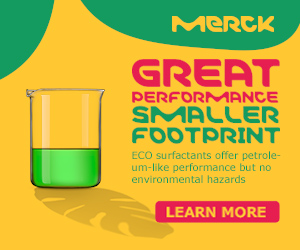Cosmetics & Personal Care
Spotlight on clean beauty 8th November 2019
By Sumit Chopra, Director Research Analysis at GlobalData
Sumit Chopra, Director Research Analysis at GlobalData, provides insights into the trends that are driving ‘Clean Beauty’.
Sumit Chopra, Director Research Analysis at GlobalData, provides insights into the trends that are driving ‘Clean Beauty’.
Growing awareness of modern consumer behaviours and their effects on the environment are encouraging consumers across the world to choose beauty products that demonstrate a commitment to mitigating their environmental impact. Consumers are seeking ‘Clean Beauty’, and brands are under increased pressure to reconsider their product formation strategies to address these demands. Manufacturers are launching an increasing number of cosmetics products that target consumers looking to capitalize on the natural properties of products, and who seek products that are chemical-free, more natural, safer and more sustainable.
Sumit Chopra, Director Research Analysis at GlobalData, provided insights into the trends that are driving Clean Beauty when we spoke to him at in-cosmetics Asia 2019.
Q: What are the main drivers of this Clean Beauty trend?
The cosmetics and toiletries industry saw some game-changing trends and innovations with opportunities existing for beauty brands to explore and expand their product appeal.
Shift Towards Green: Rising concern among consumers around green chemistry with the desire to adopt a wholesome lifestyle has given rise to the concept of organic and cruelty-free beauty products. Products claimed as vegan, organic, non-GMO and cruelty-free are creating a viable “natural” product image in the market, catering to the rising awareness of the usage of toxic chemicals in cosmetics, especially among the millennial and Gen Z generations. Therefore, manufacturers are using more organic, vegan-based, non-toxic and natural ingredients in their combinations attracting a majority of the population. According to the GlobalData Global Consumer Survey in Q3 2019, 19% of respondents are influenced by a vegan claim in their beauty products while 38% consumers look for ‘cruelty-free’ claims while purchasing their beauty products.
Wellness Revolution: The future of clean beauty not only claims to be ‘accredited’ natural or organic but also should be beneficial towards a healthy lifestyle. Brands who are putting consumers’ health at the forefront are getting more traction with cosmetics that are free from allergens and infused with natural oils. However, the beauty industry needs to be more transparent as people are waking up to the ramifications of negligence towards their health. According our survey, 58% respondents are proactively seeking products which improve their health, while the incorporation of probiotics in beauty products make it somewhat/very appealing towards 59% consumers globally.
Clean Ingredients: The rise of food-based ingredients in cosmetic products has seen brands turning to honest ingredients to cater to the rising demand for natural and vegan based organic products among environmentally conscious consumers. The “truth-seeking” nature of consumers is increasing, leading to tools and apps which scan products with the help of the barcode, to track down the source. According to our survey, 72% consumers globally find fruit/vegetable extracts somewhat/very appealing ingredient to be incorporated in the beauty products.
Simple & Clear Labelling: Ethicality and sustainability are becoming part of the natural product proposition. Zero-packaging, recycled plastic packaging and individually packaged treatments have been gaining momentum. Consumers are more inclined towards simple and fresh pack designs with clear labelling as they believe it to be more authentic.
Beauty players are under growing pressure to place sustainability and transparency at the heart of not only their brand but the product too. Brands are exploring environment-friendly formulations and packaging to enhance sustainability and even the quality credentials of their products. Globally, around 79% of consumers have stated that if a tax on products wrapped in plastic was imposed, they would buy fewer of these products or stop buying these products altogether.
Q: How do these drivers reflect the current social change – in other words, “why now?”
Demographic and consumer-driven shifts will contribute to disrupt the fast-moving consumer packaged goods industries. Here, changing consumer preferences and growing awareness of ingredients and the importance of wellness is encouraging companies to reposition themselves. At the same time, it is allowing the smaller, niche companies to emerge as millennial consumers are taking a more active, vocal role in redefining what beauty and personal care mean to them.
In recent years many major social movements have emerged and given consumers the power and the confidence to demand greater equality as well as reject traditional and often unachievable beauty standards. These global and regional campaigns have driven cultural changes, and emphasize the need for societies to build diverse and inclusive landscapes.
Considering the socio-economic change, consumers have adopted a simpler and more mindful approach to beauty and they are more interested than ever in prioritizing the absence of undesirable ingredients in products over the inclusion of beneficial ones. At the same time, brands also understand that they are catering to the next generation of conscious consumers who are seeking overall wellbeing. This has resulted in brands taking product testing to another level and clearly communicating its understanding of skin and the process of choosing its ingredients.
The future of clean beauty is about brands that do not just do things to get ‘accredited’ as natural/organic/vegan/cruelty-free but also offer guidance and initiate a dialogue regarding a shift to sustainable, high-performance cleaner products.
Q: Is consumer demand for Clean Beauty generation-specific (e.g. Millennials, Generation X)?
The clean beauty movement, once a niche trend, has gone mainstream nowadays. The “one-size-fits-all approach” in beauty is failing to truly resonate with consumers, as well as demonstrating the importance that beauty and grooming brands cater to specific needs and preferences.
In an era where disruption has become the new improvement, millennials and Gen Zers are poised to become the driving force of the ultimate beauty revolution. Millennials and Gen Zers are igniting change in the way that beauty and grooming routines are approached, demanding a more inclusive and realistic representation from the industry. They are digital natives, experience-driven, and individualistic, who are collectively defined as “pivotal”, driving brands to reinvent themselves.
Brands are making significant investments in product marketing and innovation as they recognize the consumer group comprising millennials and Gen Z as the next big consumer market and purchasing powerhouse. Conscious consumerism is the underlining trend that has pushed the clean beauty and holistic wellbeing market to an all-time high, with millennials and Gen Z leading the way.
According to our survey, 44% of Gen Z and 51% of millennials in APAC responded that they actively/completely look for “vegan” products while purchasing beauty and grooming products. While 49% of Gen Z and 62% actively/completely look for “cruelty-free” products. All this has created opportunities for companies to attract this generation through new product launches and creative marketing strategies.
Q: Which world regions are leading this trend?
The largest and fastest-growing beauty market is Asia, followed by The Middle East & Africa, and Australasia. In comparison, regions such as Western Europe and North America showcase some of the lowest levels of forecast growth which can be attributed to the beauty market being much more mature in these regions.
When it comes to clean beauty, consumers often consider US and European originated beauty products to be of better quality. There has been consecutive growth in the number of beauty product launches across various brands, especially in regions such as Europe, thereby, pushing the sector on its growth trajectory.
Q: Is this a permanent shift in consumer focus to which manufacturers must adapt?
The emergence of “clean beauty” has driven scrutiny around the use of ingredients and production methods used. As a result, manufacturers are encouraged to emphasise the simplicity of their products, the ingredients used and the consumer’s skincare routine. There has been increased awareness about the predominantly unregulated beauty market, putting more pressure on manufacturers to look for new ways to better align with the clean beauty trend.
Brands need to figure out a sweet spot between natural and effective products as consumers become more conscious about the efficacy of the products they buy. In a scenario where traditional notions of beauty are changing, there has been a shift towards aspirational wellness leading to the emergence of a new segment: ‘wellcare’. And, with consumers being increasingly put off by brands that project a tightly defined and stereotypical portrayal of beauty, they need to consider all these factors to strategize on future beauty innovations.
Q: Should manufacturers of speciality chemicals view this trend as a business opportunity?
Clean label is no longer a fad or a trend but a new norm across the FMCG industry. The clean beauty concept has been thrust into the spotlight over the past few years in the beauty space as health-conscious and eco-friendly consumers want to know what they are buying. Manufacturers of speciality chemicals have the opportunity to create competitive-edge based on product differentiation, present themselves with a clear purpose that transcends from their products into the minds of consumers and drive the changing conversation of beauty. Speciality product claims can easily garner consumer trust and provide a clear signpost for differentiation, which can further be translated into higher consumer spending, loyalty and repeat purchases.



